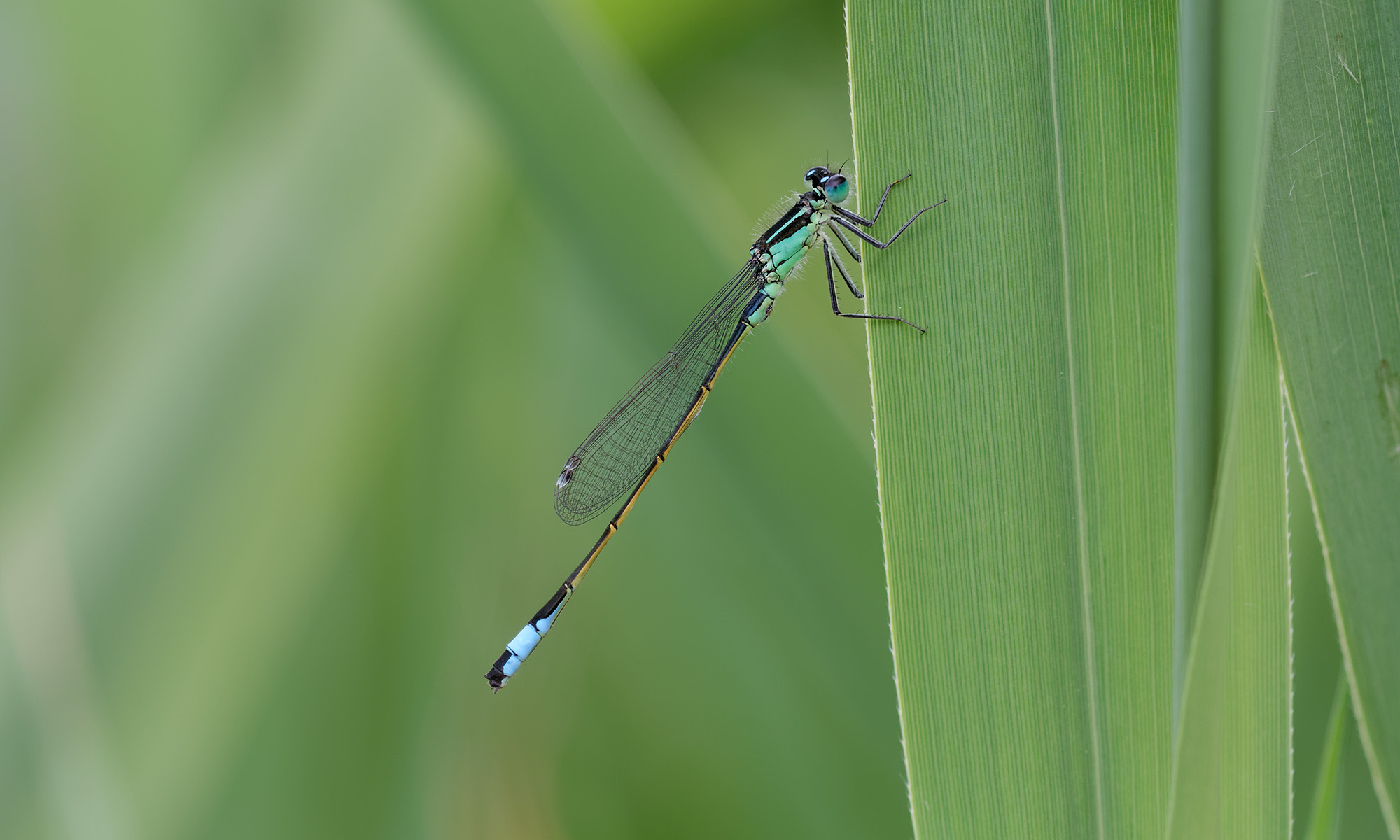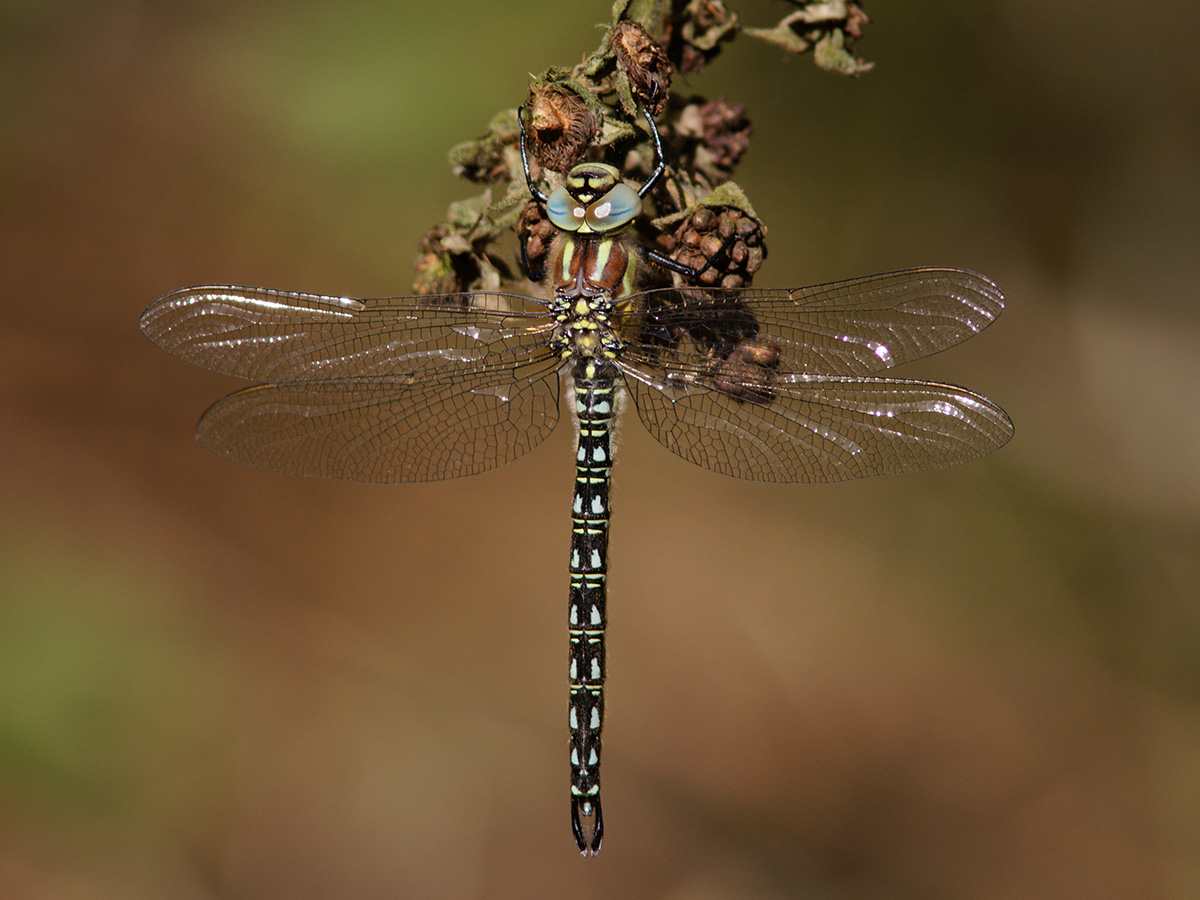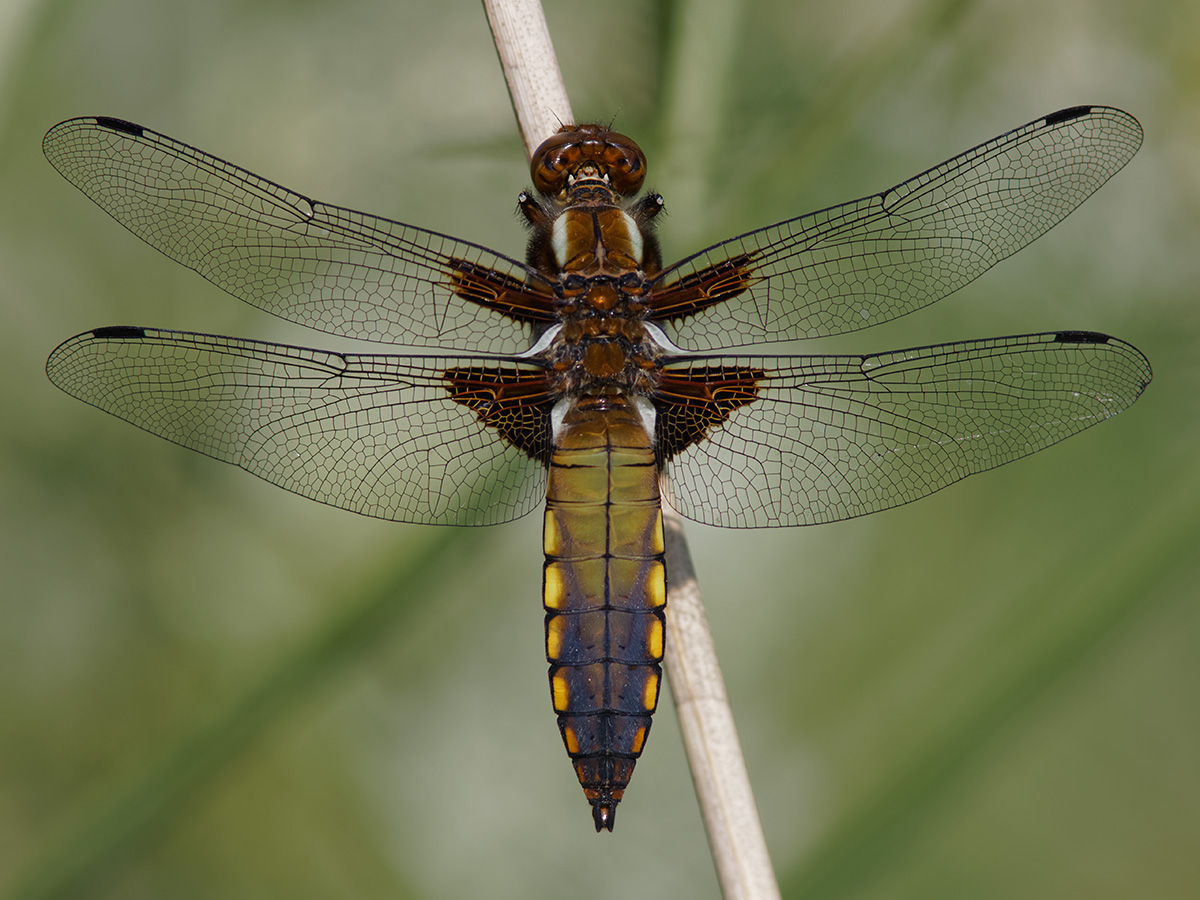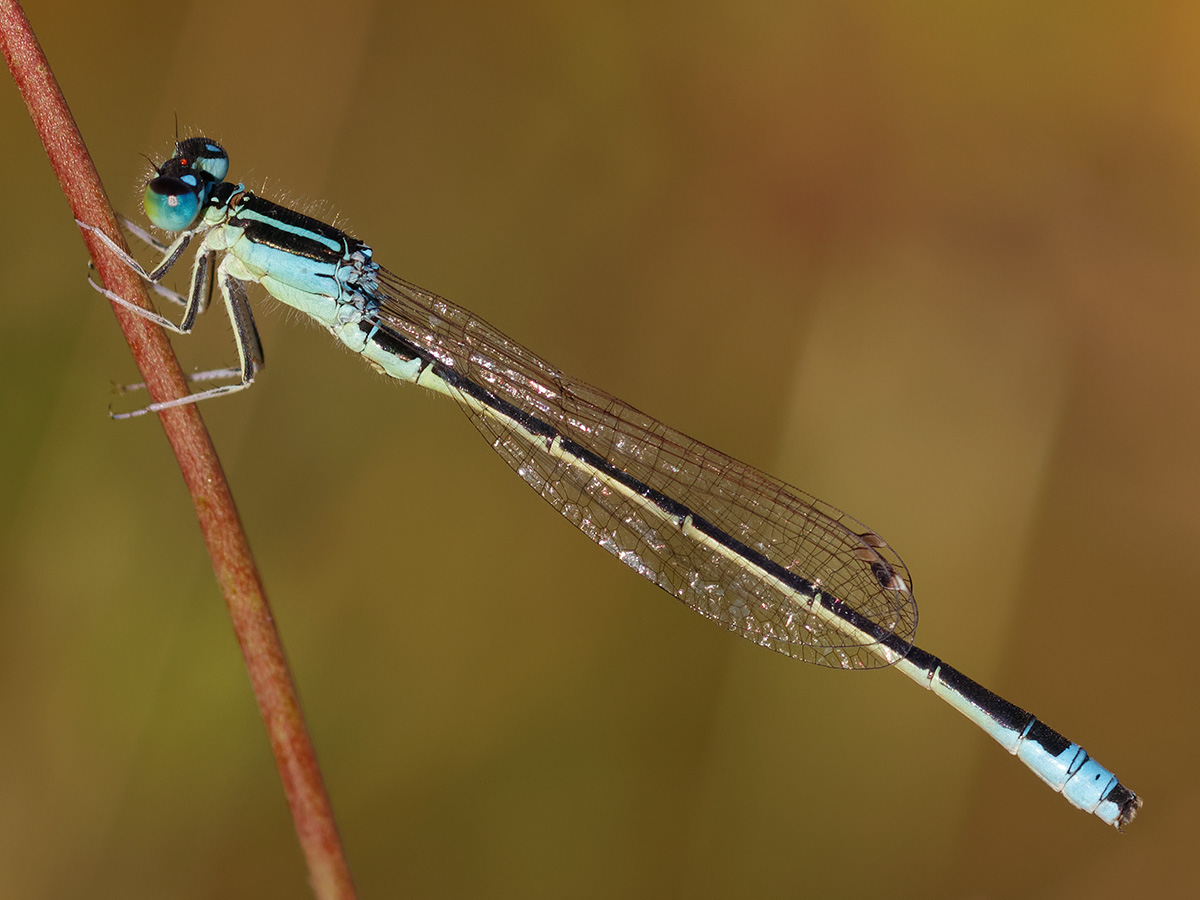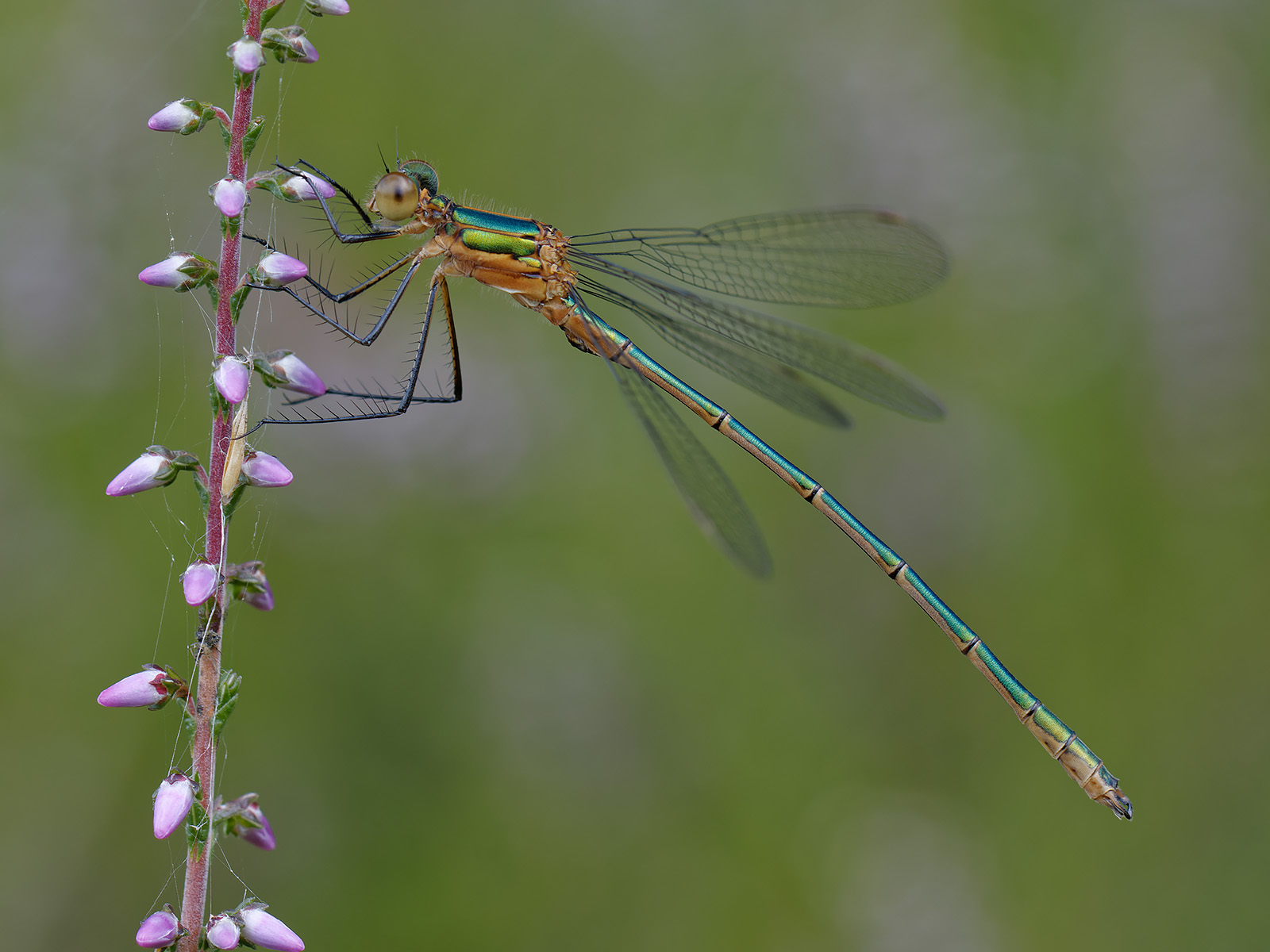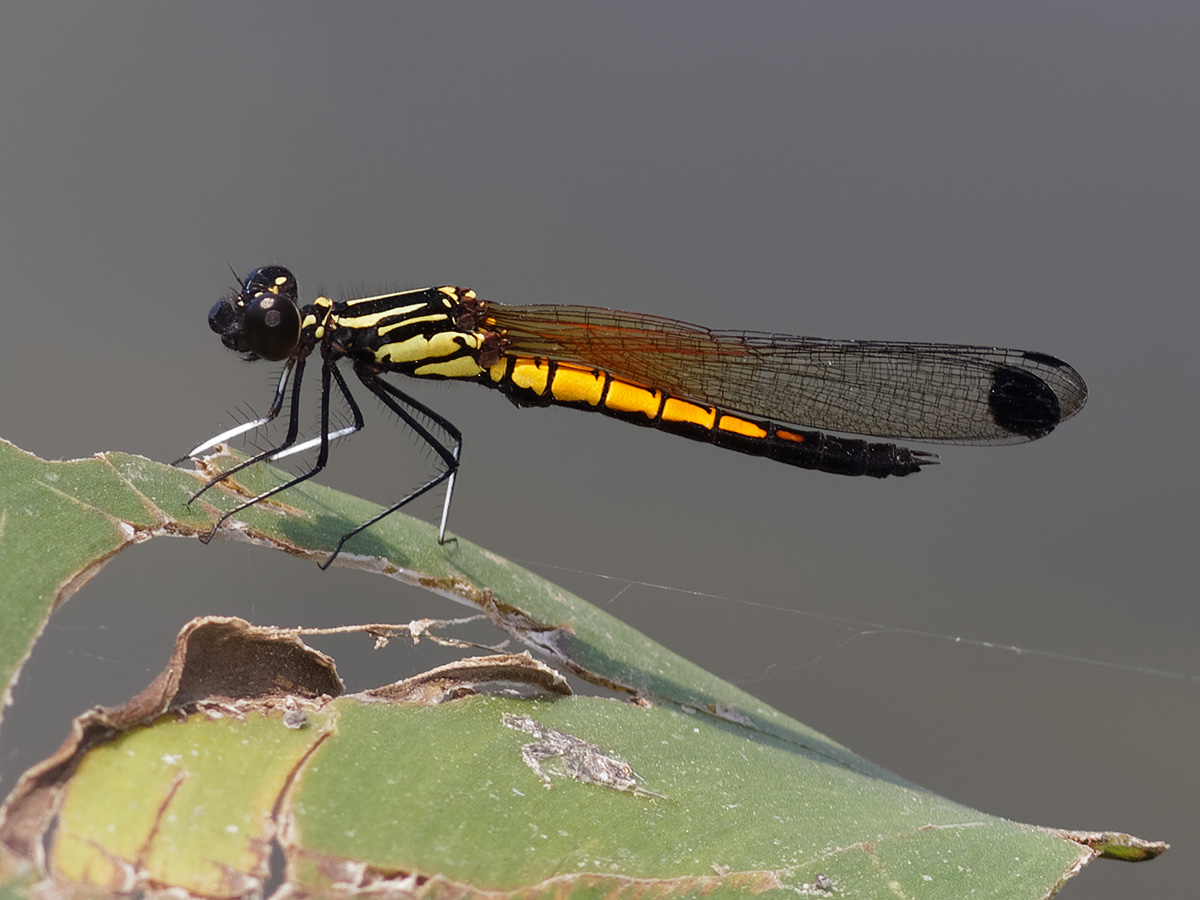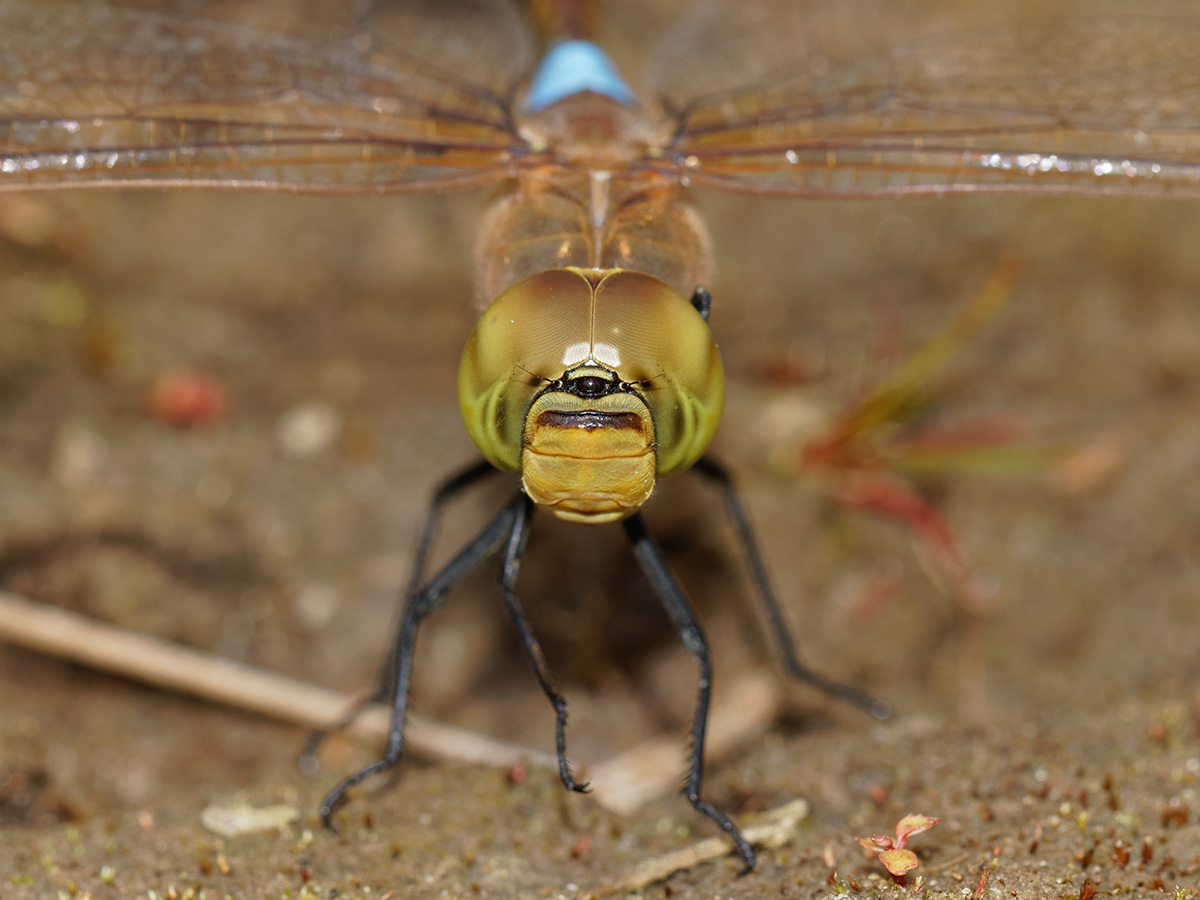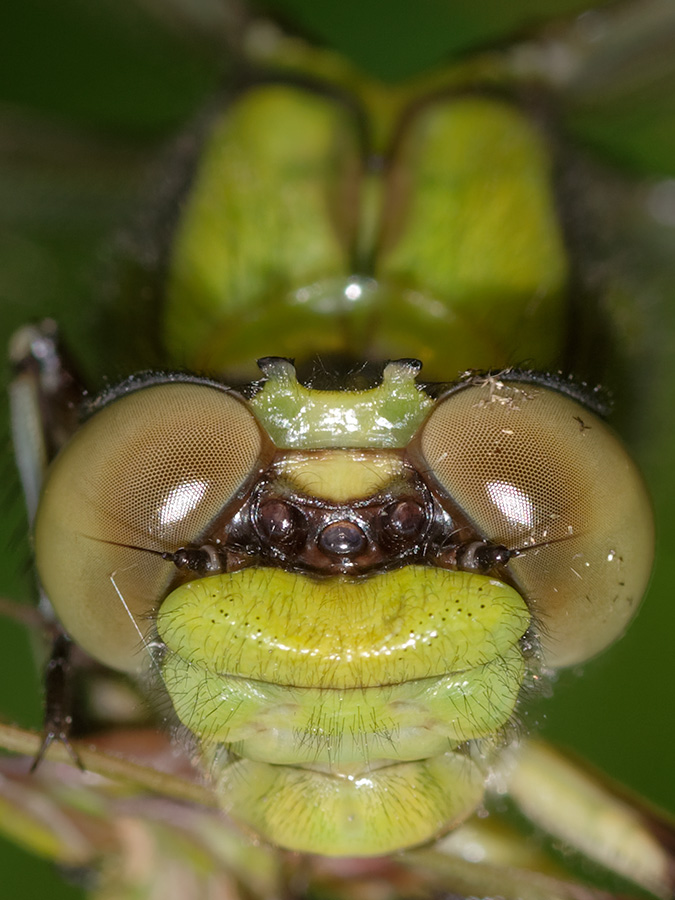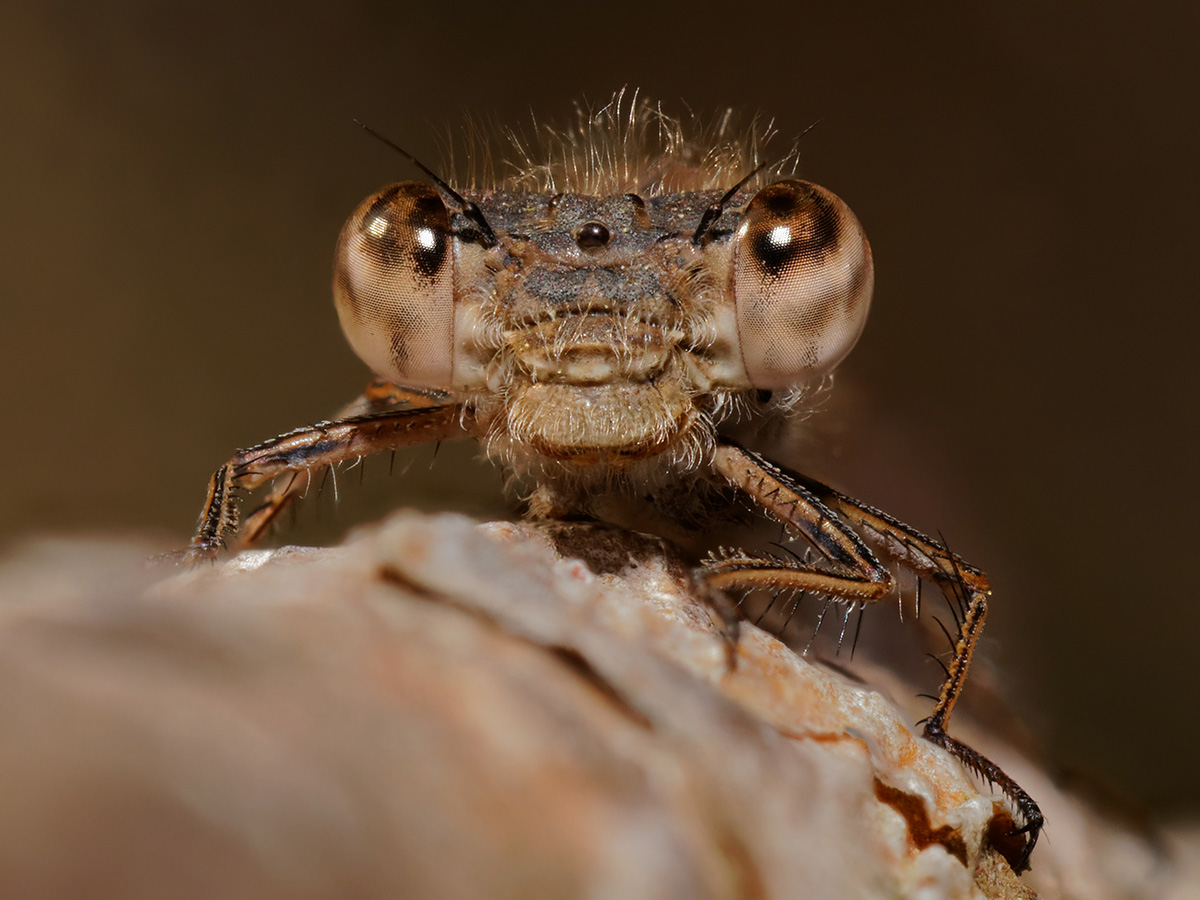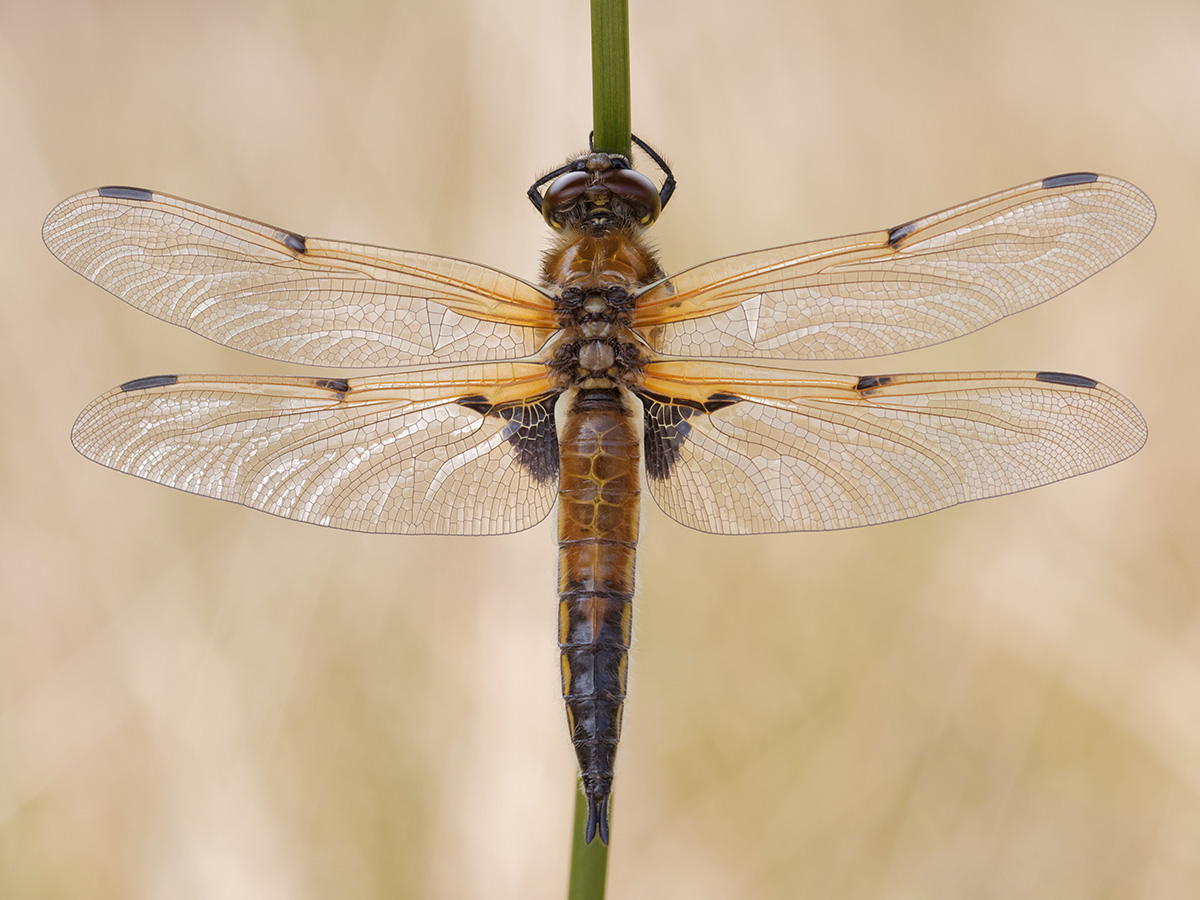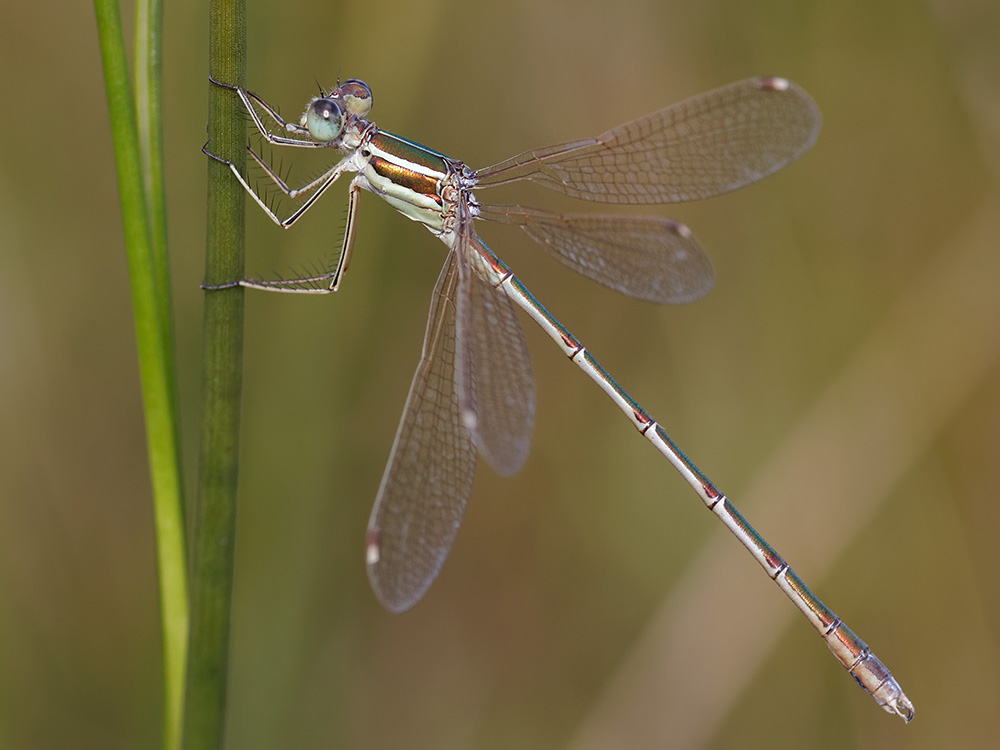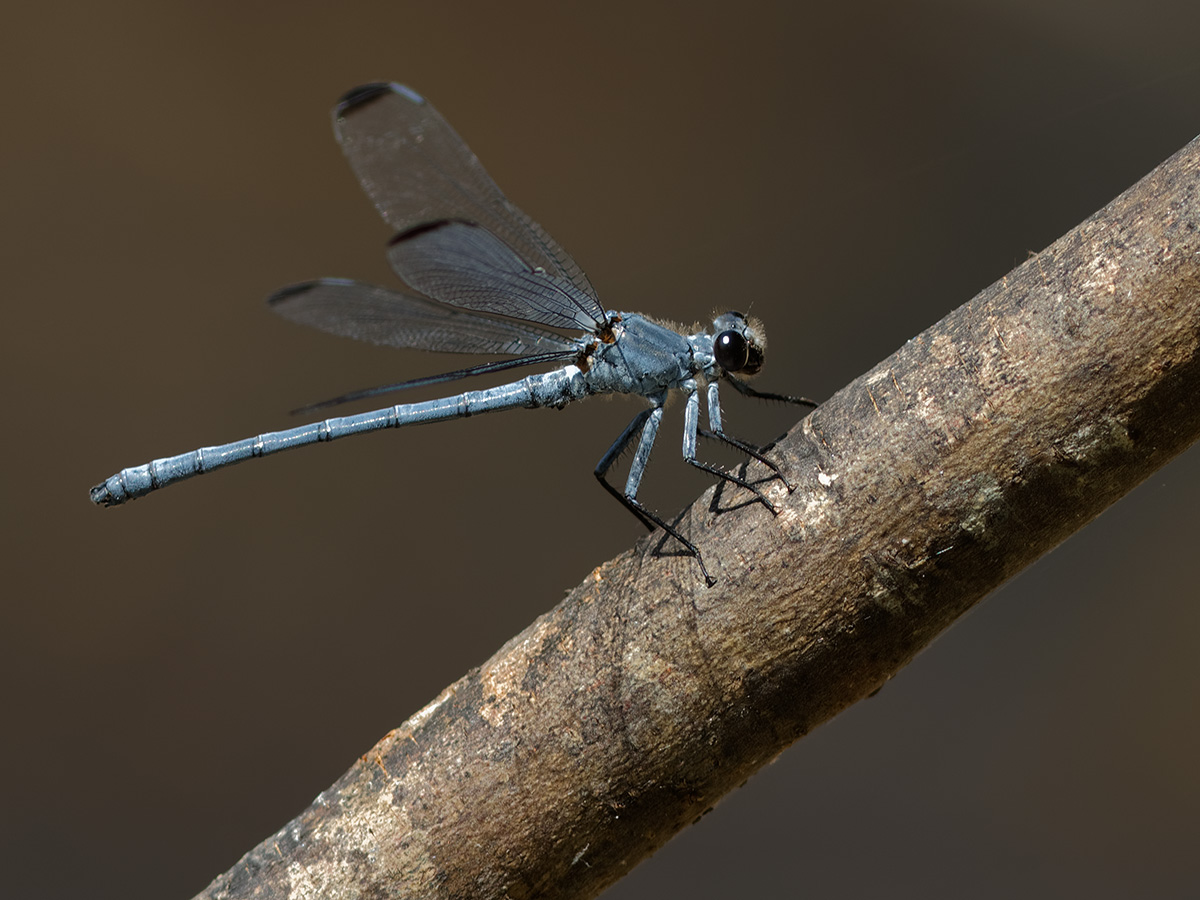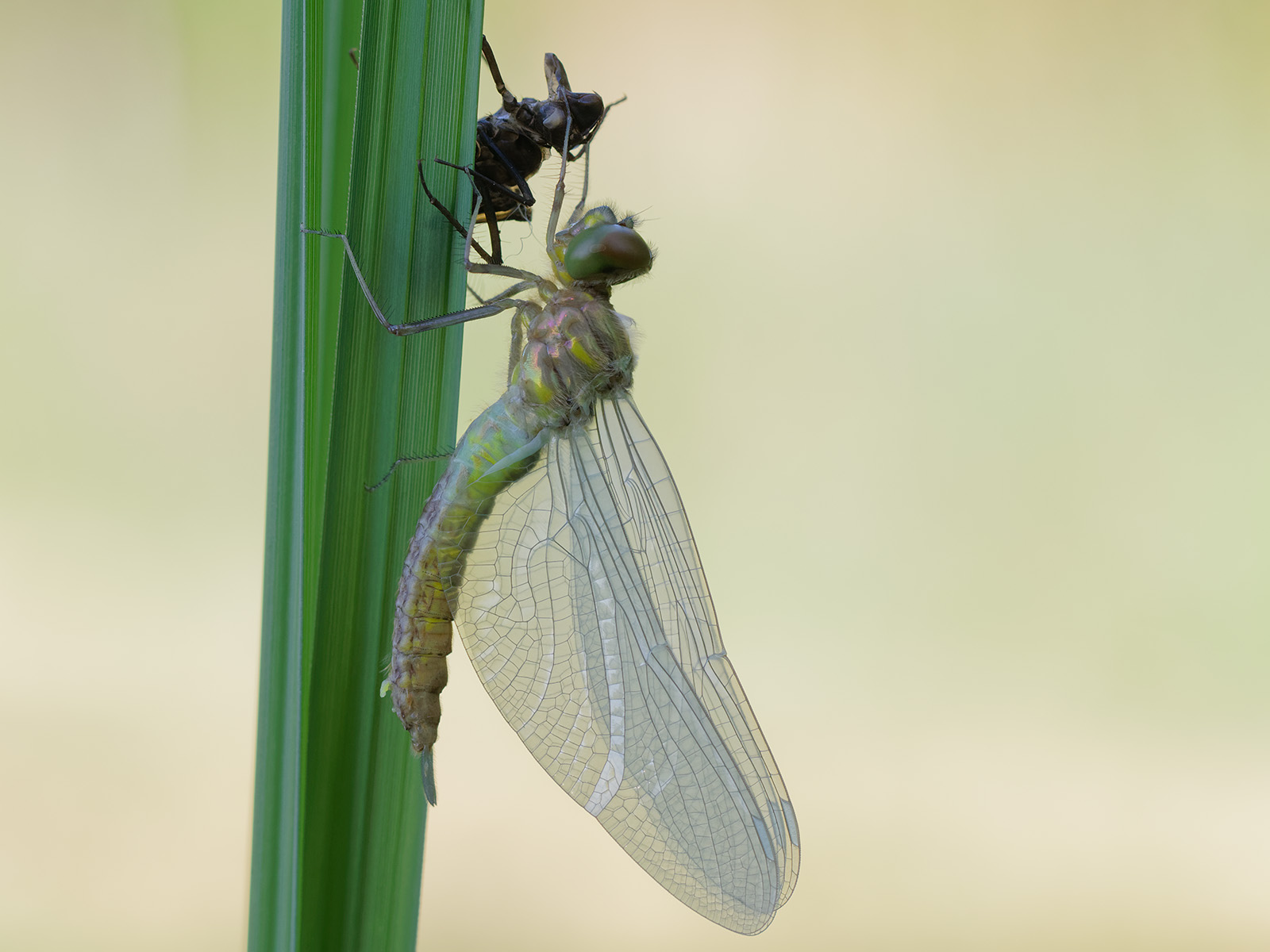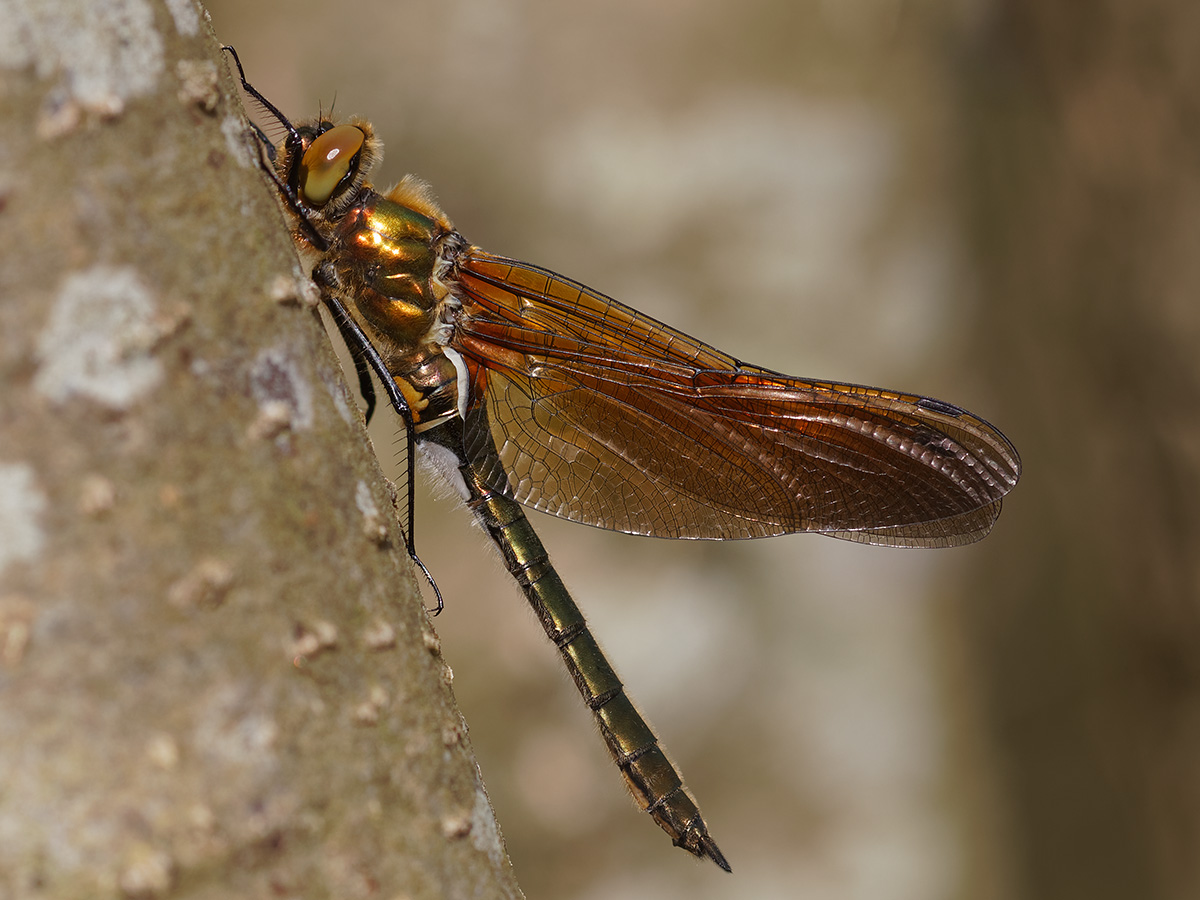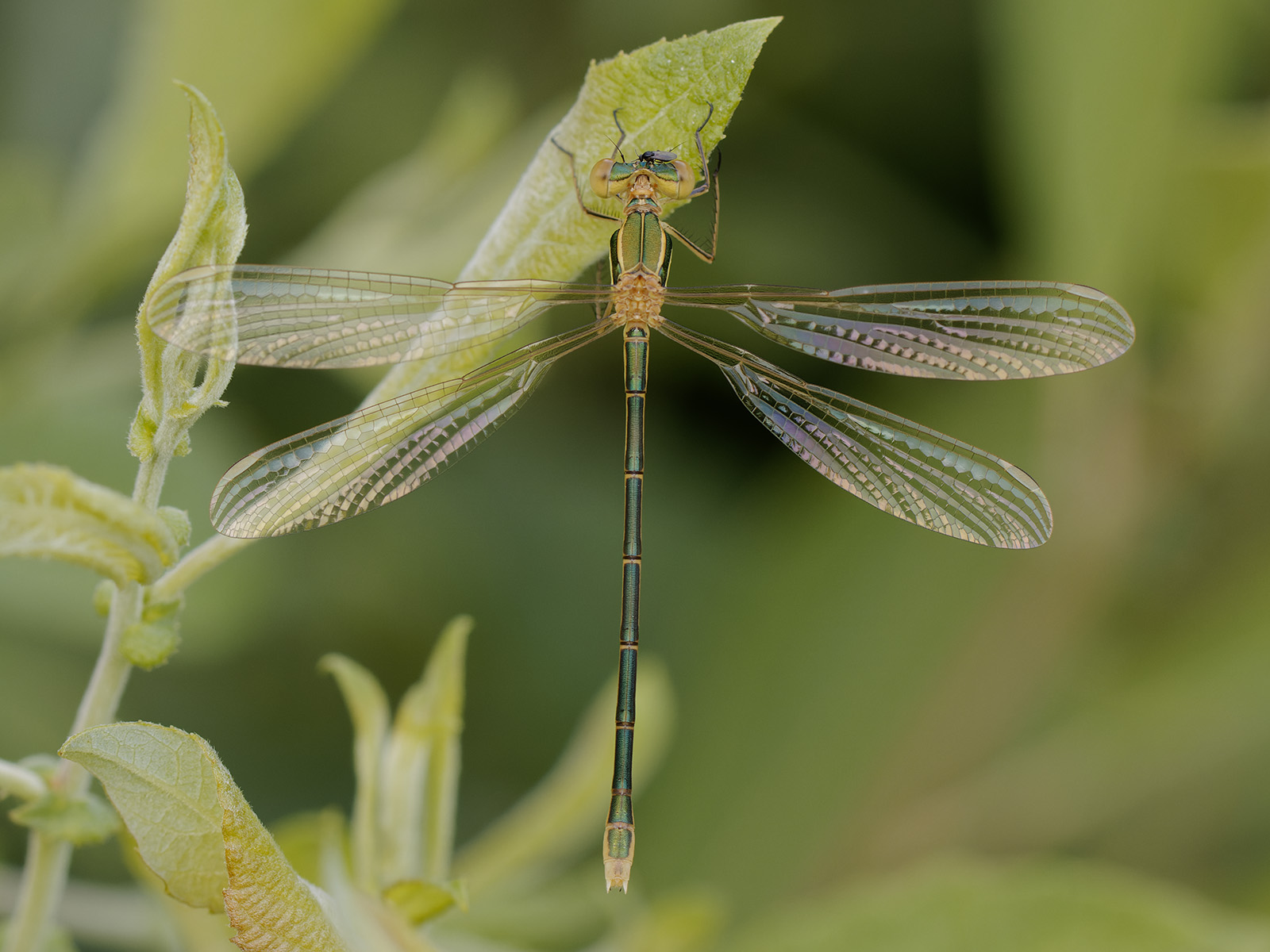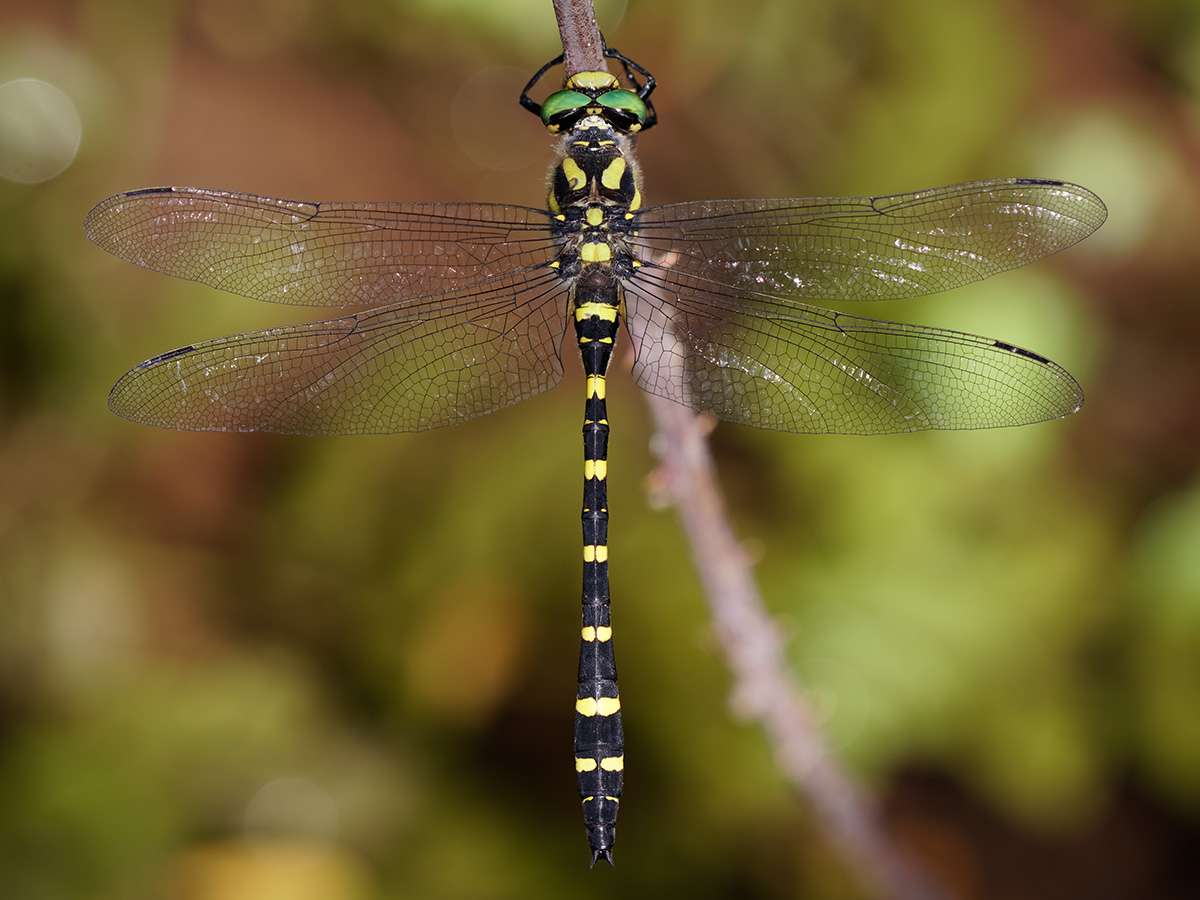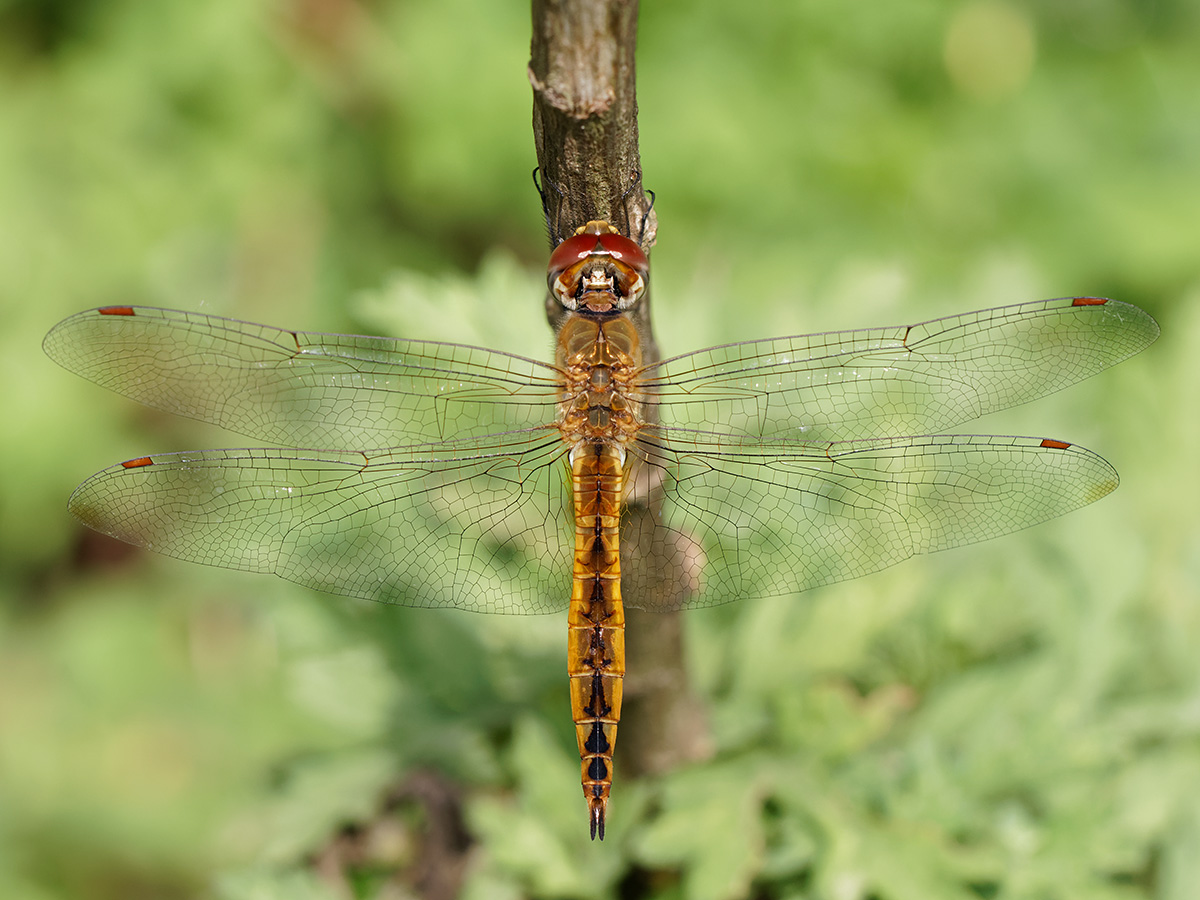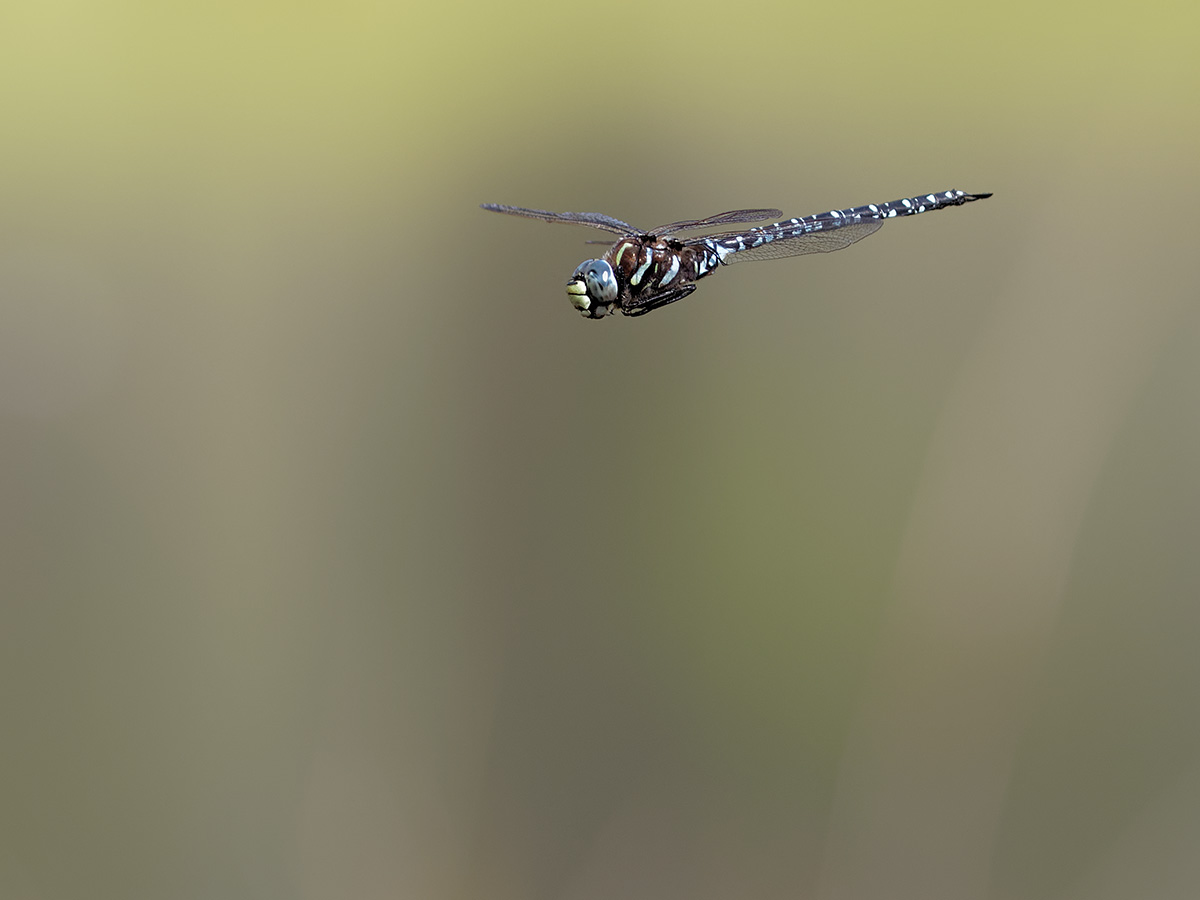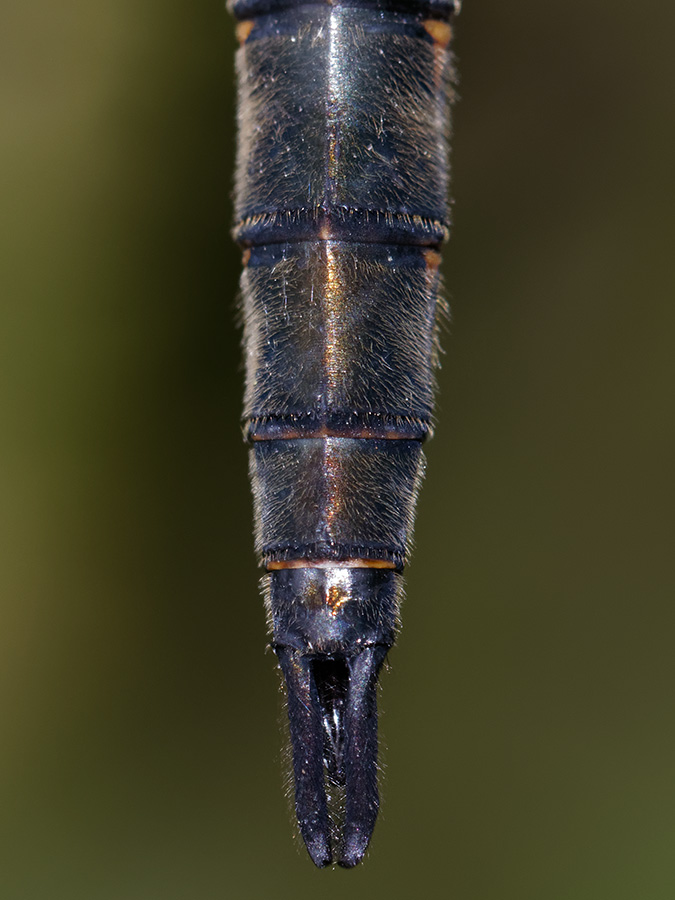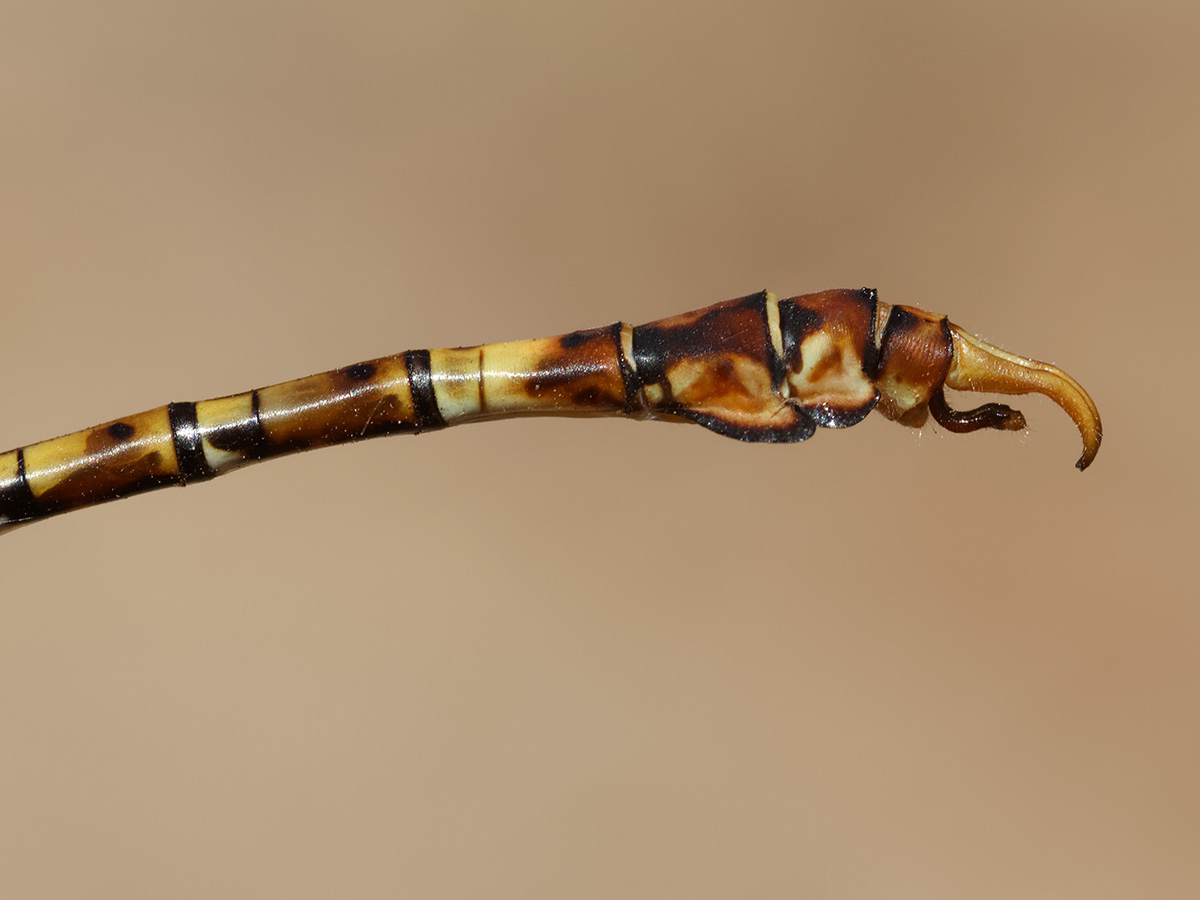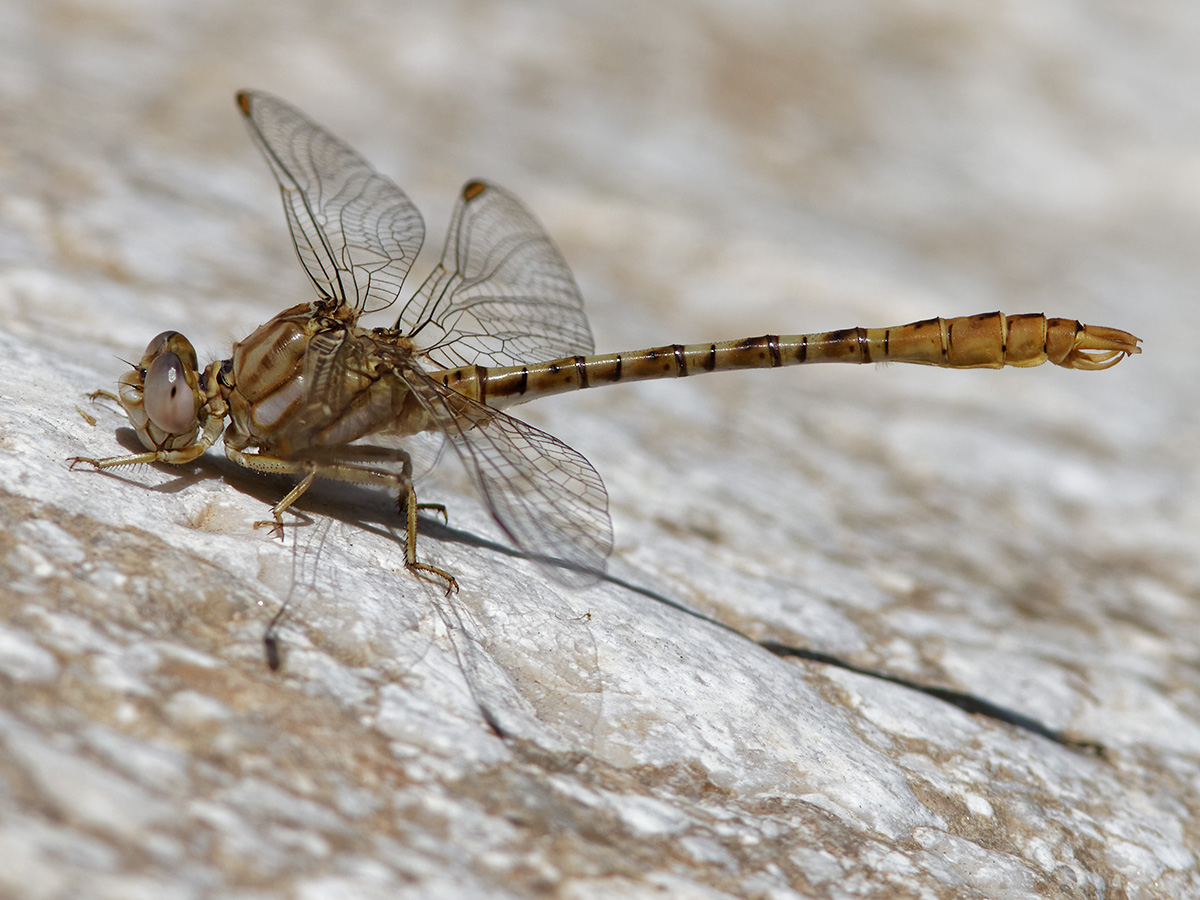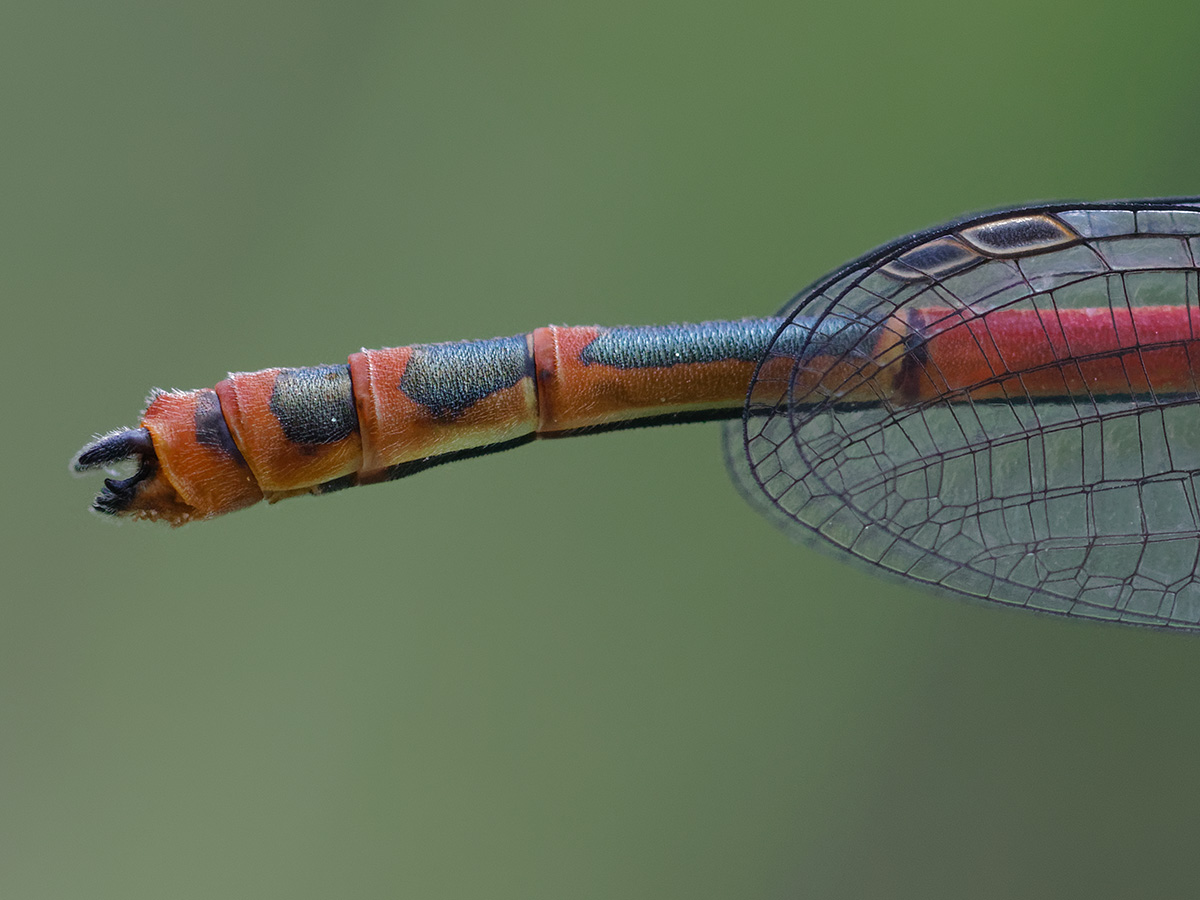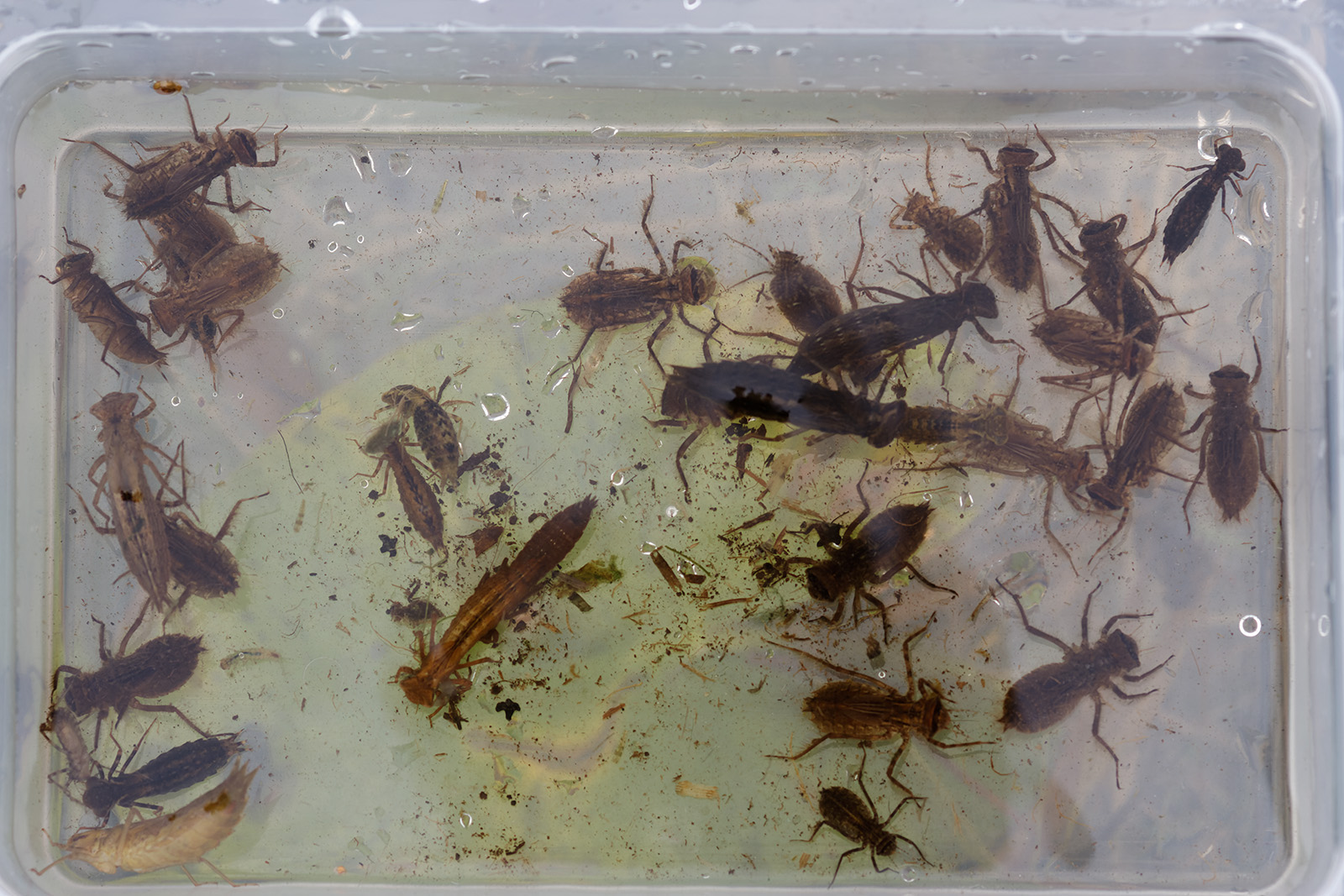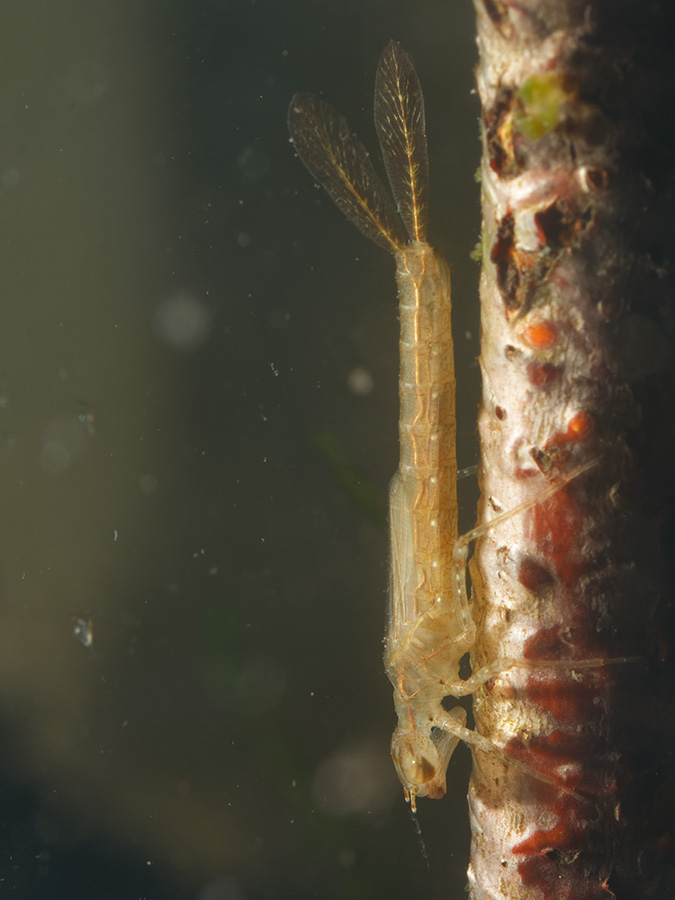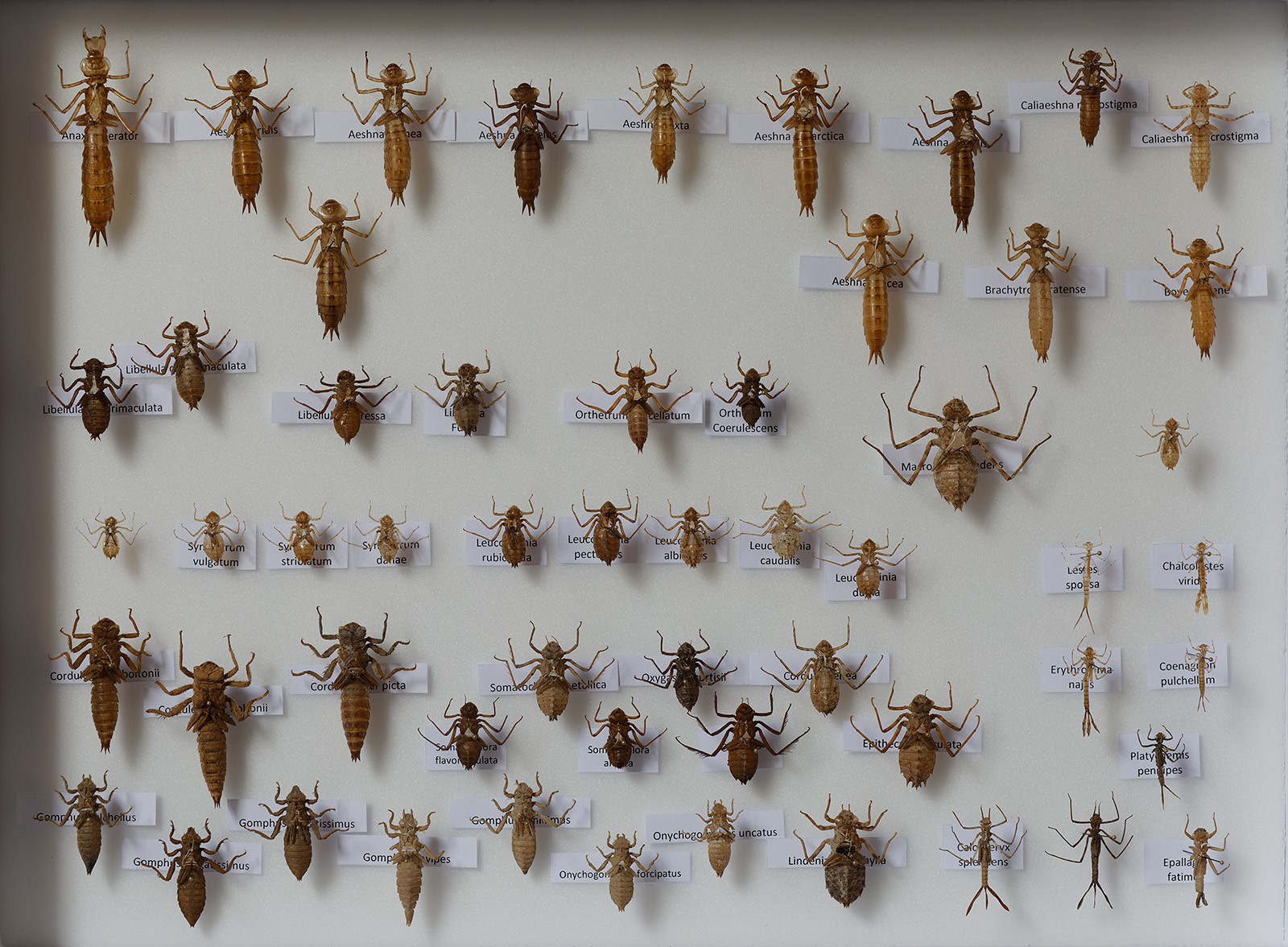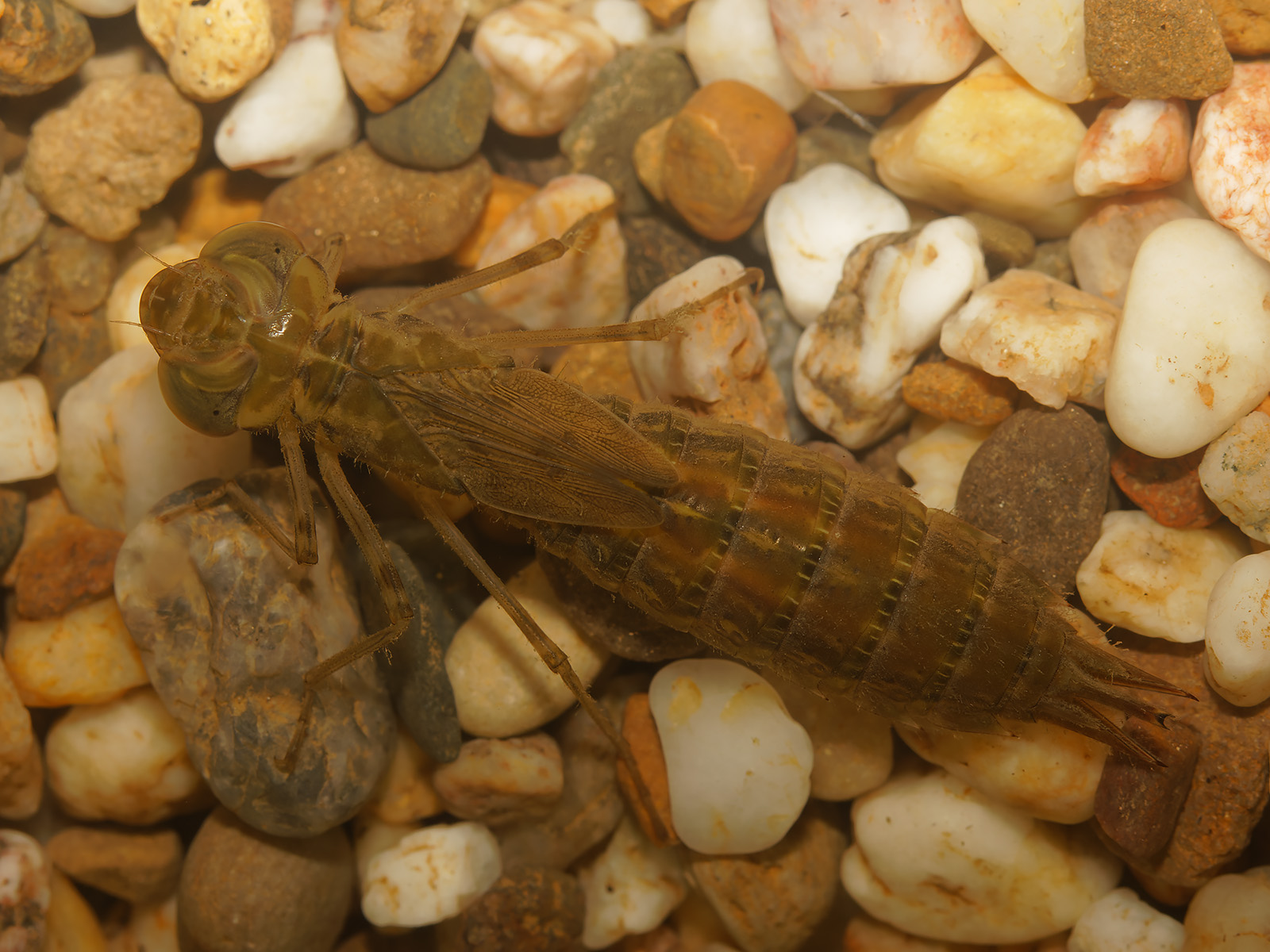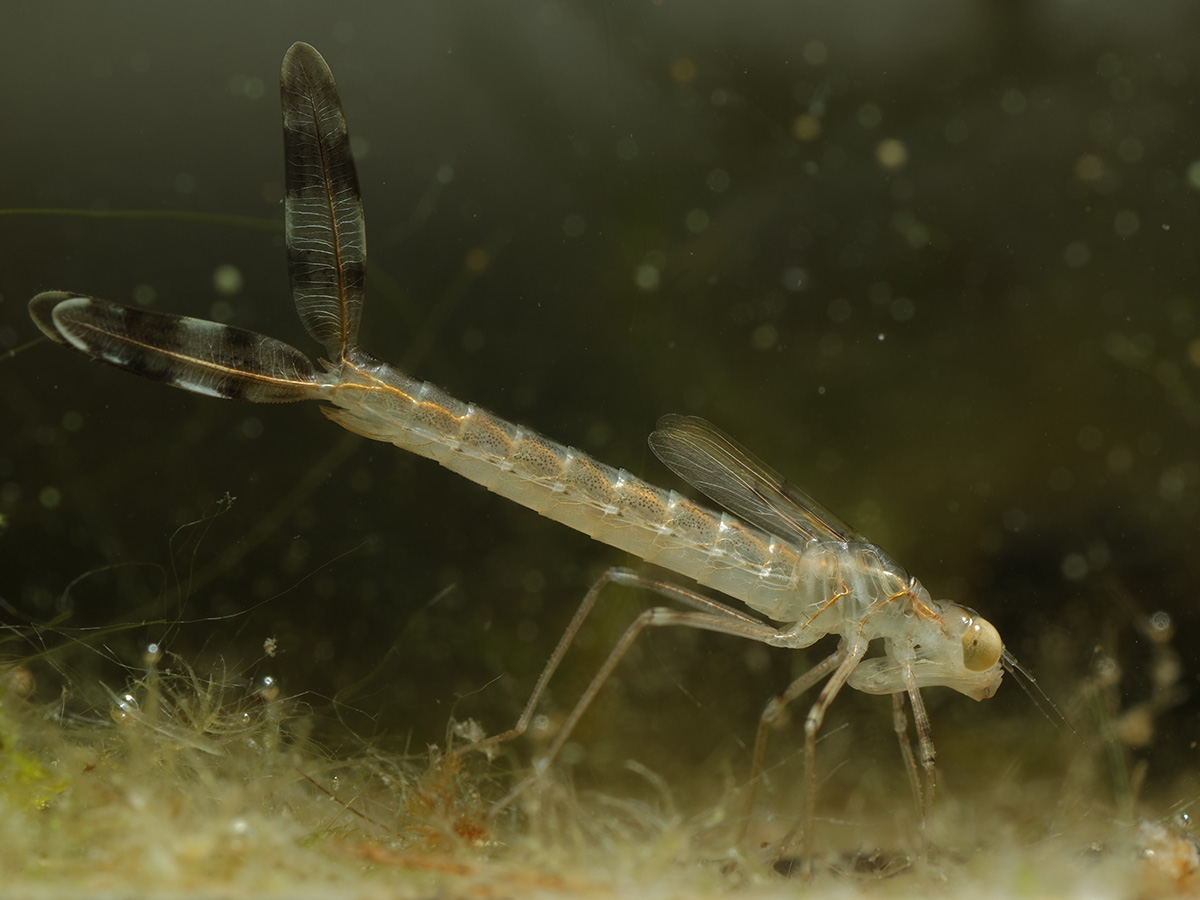Introduction
Odonata is the name of the insect order containing both (true) dragonflies (Anisoptera) and damselflies (Zygoptera). Although these two suborders share many characteristics and are often confused, they aren’t exactly the same thing. This page is dedicated to the differences and should be helpful for those who want to know how to tell either imagos or nymphs of the two suborders apart.
Imagos
Body shape
Although there are exceptions on both sides, damselflies can be described as long and thin, especially around the abdomen, while dragonflies are mostly built broader, relatively shorter and stouter. Because of the aforementioned exceptions this difference is to be taken as an indication. For instance, members of the tropical family Chlorocyphidae (jewels) like Libellago lineata have an a-typically short, stocky abdomen but they’re damselflies nonetheless.
True dragonflies: Stout cilindrical abdomen on Brachytron pratense (1), club-shaped abdomen on Gomphus vulgatissimus (2) and flattened, broad abdomen on Libellula depressa (3).
Damselflies: Typical thin cilindrical abdomen on Ischnura pumilio (4) and Lestes sponsa (5). Short, thick and flattened abdomen on Libellago lineata from Nepal (6).
Size of the eyes and shape of the head
Another helpful feature is the shape of the head. Dragonflies have big eyes that (usually) touch on top of their head. Damselflies have much smaller, round eyes, which are positioned widely separated on the sides of the head. Once again there are exceptions: some dragonflies have eyes that don’t touch on top of their head. In Europe this exception is limited to all members of the Gomphidae (clubtails) family. Outside Europe it includes other families such as Petaluridae (petaltails), and some special cases within other families such as the genus Diastatops (colourful Libellulidae from central and south America). However, even in these exceptional cases, the eyes are much larger than in damselflies. The head shape of damselflies is sometimes compared to hammerhead sharks: the eyes are located on the side of the head and spaced very far apart. This characteristic is most obvious in the Platycnemididae (white-legged damselflies) family, where the eyes are even further apart than in other families.
True dragonflies: typical head shape on Anax ephippiger (1). Large eyes set apart on Ophiogomphus cecilia (2).
Damselfly: small eyes located on the side of the head, far apart, on Sympecma fusca (3)
Wing position at rest
A much-used characteristic to distinguish dragonflies from damselflies is the position in which the wings are held when the animal is at rest. True dragonflies hold their wings spread like an airplane. Damselflies fold back their wings and hold them along their abdomen.
1: Typical true dragonfly: Libellula quadrimaculata
2: Typical damselfly: Pyrrhosoma nymphula
Unsurprisingly, there are exceptions here as well: some damselflies keep their wings more or less spread at rest and some dragonflies can be found with their wings folded over their back. Among the European damselflies the family Lestidae are known for keeping their wings spread, which accounts for their common name: Spreadwings. Exception within this exception being the two winter damselflies, Sympecma fusca and S. paedisca. Odalisques (Epallage fatime, the sole European representative of family Euphaeidae, gossamerwings) tend to rest with their wings spread as well and can be mistaken for true dragonflies because of their stout appearance and strong flight.
1: Damselfly with wings spread: Lestes barbarus
2: Damselfly with wings spread: Epallage fatime
In Europe, true dragonflies that are found with their wings folded together above the back are always newly emerged specimens. The wings normally open for the first and final time shortly before the first flight. In some species, the fragile wings are sometimes folded above their back after the first flights. Species which are known for this are the Downy Emerald (Cordulia aenea) and the Hairy Dragonfly (Brachytron pratense), both early spring species, where fresh specimens often have dark wings. Presumably, the dark wing colour and the folding back of the wings in cold weather serve as means for thermoregulation. Species of true dragonflies which still fold back their wings after hardening do not exist in Europe, but worldwide such exceptions do exist. Shutwings (Cordulephya sp., family Corduliidae, emeralds), for example, are small true dragonflies, endemic to eastern Australia, which fold their wings above their body when at rest. Males of the neotropical Zenithoptera species (family Libellulidae, skimmers or perchers) are known to open and close their distinctive blue wings when resting.
1: True dragonfly, wings shut before maiden flight: Somatochlora flavomaculata emerging
2: True dragonfly, wings shut after maiden flight: a freshly emerged Cordulia aenea
Wing shape
The most reliable way to tell whether you are dealing with a dragonfly or a damselfly is the shape of its wings. The four wings of a damselfly all share the same shape: narrow and stalked at the base, gradually widening to the widest part at about 2/3 of the length and ending in a rounded tip. The fact that the four wings have the same shape is reflected in the scientific name of the suborder to which damselflies belong: Zygoptera is a contraction of the Ancient Greek words ζυγός (zygos, meaning “unequal”) and πτερά (ptera, plural of πτερόν, pteron, “wing”).
Four equally shaped wings per damselfly. 1: Lestes barbarus, freshly emerged female. 2: Calopteryx splendens sometimes sleep with their wings in opened position.
In true dragonflies, the front and rear wings are unequal in shape. The front wings are narrow at the base, gradually becoming wider to about 2/3 of their length and narrowing again to a rounded tip. The rear wings widen radically immediately after the base, the widest part being at 1/4 of the length or even closer to the body. From the widest part, they gradually narrow again towards the rounded tip of the wing. As with damselflies, the characteristic wing shape is reflected by the scientific name of the suborder: Anisoptera derives from the Ancient Greek ἄνισος (anisos, “uneven”) and πτερά (ptera, plural of πτερόν, pteron, “wing”).
Front and rear wings differ in shape; Cordulegaster heros (1) and Pantala flavescens (2) are true dragonflies.
The differences in the wing shapes of true dragonflies and damselflies affect their ability to fly. Both are aerial acrobats: dragonflies and damselflies can hover in the air, fly backwards and take off and land vertically. However, flight of damselflies is generally slower and less powerful than that of true dragonflies. The broad hind wings of true dragonflies allow gliding which enables them to cover large distances with minimal effort. Although long-distance dispersal has been demonstrated in damselflies (e.g. Ischnura hastata ending up on the Azores from North America), long-distance migration is usually reserved for true dragonflies. The best-known species of migratory insects is a true dragonfly: Pantala flavescens (Wandering Glider or Globe Skimmer, shown above) is known for its multi-generation seasonal migration between the Indian subcontinent and east Africa vice versa. This migration circle, with a total length of about 14.000 km, is among the farthest known migrations of all insect species.
Gliding true dragonflies. Aeshna subarctica (1) and Anax parthenope (2)
Male appendages
The abdomen of both true dragonflies and damselflies terminates in a collection of terminal appendages. Females of both suborders have 2 appendages, called cerci (plural of cercus). Although the size and shape of the male appendages varies greatly, true dragonfly males always have 3 terminal appendages. The upper appendages are called cerci, like those of the female, while the singular lower appendage is called epiproct. In rare cases, the epiproct is two-pronged, as in the Mediterranean Gomphid Onychogomphus costae (Faded Pincertail). What seem to be two lower appendages is in fact one branched epiproct.
1: Dorsal view (= from the back) of the abdomen and appendages of Somatochlora flavomaculata. Two cerci on top, one epiproct just visible below them in the middle.
2: Lateral view (= from the side) of the abdomen and appendages of Paragomphus genei with large hook-shaped cerci on top, shorter epiproct below.
3: Onychogomphus costae‘s epiproct looks like it consists of 2 appendages but it’s really just one two-pronged epiproct.
Damselfly males have 4 appendages. The two upper appendages are called cerci, the two lower appendages are called paraprocts. In most species the cerci are longer than the paraprocts but exceptions where it’s the other way around exist, like Coenagrion armatum (Dark Bluet).
1: Lateral view (= from the side) of the abdomen and appendages of Pyrrhosoma nympula. Cerci on top, pronged paraprocts below.
2: Dorsal view (= from the back) of the abdomen and appendages of Lestes dryas with large cerci on top, spatula-shaped paraprocts below.
3: Coenagrion armatum‘s paraprocts are much larger than the cerci.
Nymphs
Body shape
True dragonfly nymphs are generally larger and stockier than damselfly nymphs. Nymphs of true dragonflies vary greatly in shape and size. Their abdomen can be long and torpedo-shaped or almost round and equally wide as it’s long. Damselfly nymphs are generally long and slender, with a thin and straight abdomen. A display case with pinned exuviae (= empty exoskeletons left behind when dragonflies and damselflies emerge) as shown below gives a good impression of the variety of body shape and size of the nymphs of different species. Here the exuviae of various damselfly species are shown on the bottom right and true dragonflies in the rest of the frame.
1: a mix of true dragonfly nymphs caught during an NVL (Dutch dragonfly society) field trip for educational purposes.
2: a damselfly nymph; Coenagrion lunulatum.
3: reference collection of exuviae of a variety of European species, pinned for display. Private collection Antoine van der Heijden
Appendages
Much like imagos, nymphs of true dragonflies and damselflies can be distinguished by taking a look at the appendages at the tip of their abdomen. Damselfly nymphs have three large, leaf-shaped appendages called caudal gills. These caudal gills are richly veined and are used for oxygen uptake. In addition, they are used for swimming, during which the entire abdomen is flicked alternately to the left and right.
Nymphs of true dragonflies don’t have caudal gills. For oxygen uptake they rely on gills inside the anal cavity. This cavity is surrounded by five appendages, which together are called the anal pyramid. From top to bottom these appendages are one epiproct, two cerci and two paraprocts.
True dragonfly nymph (1): the abdomen (in this case of Anax ephippiger) ends in 5 thorny appendages.
Damselfly nymph (2): nymphs of Chalcolestes viridis have conspicuous, banded caudal gills.
Anisozygoptera: the tiny and mysterious third suborder
Besides Anisoptera and Zygoptera, there is a small third suborder within Odonata: Anisozygoptera. This suborder contains only one genus, Epiophlebia. Epiophlebia superstes is endemic to Japan. E. laidlawii is known only from the Himalayas, from eastern Nepal to Sikkim (India) and Bhutan. In addition, two species have been described of which only larvae have been found: E. diana and E. sinensis, both from China. However, Epiophlebia diana has been demoted to a junior synonym of E. laidlawi in recent research.
In terms of physical characteristics, Anisozygoptera sit between true dragonflies and damselflies: the front and rear wings are slender and equally shaped and are held above the body when at rest. The eyes are separated but the head shape is most reminiscent of a real dragonfly. The thorax and abdomen are also most reminiscent of those of a true dragonfly. The nymphs look mostly like true dragonflies but share some characteristics with damseflies. Anisozygoptera inhabit fast-flowing, cold rivers. Fully grown E. superstes nymphs are known to leave the water and live a semi-terrestrial life for weeks before emerging in spring.
